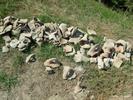Qabala or Gabala is the most ancient city of Azerbaijan and the capital of the Qabala Rayon of Azerbaijan. Before 1991 the city was known as Kutkashen, but after Azerbaijan's independence the town was renamed in honour of the much older city of Gabala, the former capital of Caucasian Albania, the archaeological site of which is about 20 km southwest.
Qabala town isn't a great attraction but there are attractive picnic spots and streamside restaurants 4km north. Many more appealing villages lie in the surrounding valleys from which you could hike into the high mountains.
Qabala's centre is the junction of Heydar Aliyev kuc and Qutqashinli pr, a point unanimously known as Saat Yani. That means 'beside the clock', though the clock tower for which it was named has since been replaced by a globe-on-a-stick monument. One block east is the colonnaded 19th-century mosque (Heydar Aliyev kuc). Around 500m south is the new Historical Museum. It displays finds from Old Qabala but its most intriguing feature is the fake Stone Age-style swing gate through which one enters. Next door is a typically grand, wordless Heydar Aliyev Museum.
History
Qabala is ancient capital of the Caucasian Albania. Archeological evidence indicates that the city functioned as the capital of the Caucasian Albania as early as the fourth century BC. Ruins of the ancient town are in 15 km from regional center, allocated on the territory between Garachay and Jourluchay rivers. Qabala was located in the middle of the 2500 old Silk Road and was mentioned in works of Pliny the Younger as "Kabalaka", Greek geographer Ptolemy as "Khabala", Arabic historian Ahmad ibn Yahya al-Baladhuri as "Khazar". In the 19th century, the Azerbaijani historian Abbasgulu Bakikhanov mentioned in his book "Gulistani Irem" that Kbala or Khabala were in fact Qabala. In 60s BC, Roman troops attacked Caucasian Albania but did not succeed in capturing the Qabala territory. In 262, Caucasian Albania was occupied by Sassanid Empire but preserved its political and economic status. In 464 AD, lost its independence due to years of invasions from the northern nomadic tribes and had to move its capital city to Partava (currently Barda in Azerbaijan). Qabala was occupied by Shirvanshah Fariburz, Georgian King David III of Tao in 1120, Mongol khan Timurleng in 1386, Safavid shah Tahmasib I in 1538, Persian Nader Shah in 1734 but was able to preserve its culture and identity. After the death of Nader Shah in 1747, Azerbaijan split into independent khanates and sultanates and Qabala became a Qutqashen Sultanate. It was also called Qabala Mahali. After Azerbaijan was occupied by Russian Empire in 1813 it conducted administrative reforms and in 1841 Azerbaijani khanates were terminated and the territories were incorporated into governorates. Qabala area was added to Nukha uyezd of Elisabethpol Governorate. Due to archeological finds in Qabala, it was declared a National State Reserve in 1985.
Old Qabala never recovered and the unguarded site (admission free) was only rediscovered in 1959. There's little to see apart from the stumps of two massive brick gate towers at the southern perimeter. Near the site's northwest entrance, the delightful Qala Salbir Kafesi sits in pretty woodland beside a fishpond. The owner is keen to show the extraordinary collection of ancient coins he apparently found while nosing around the ancient site.
Getting There & Away
The bus station (avtovagzal; Qutqashinli pr) is 2km south of Saat Yani. From here marshrutkas leave around twice hourly to Baku (five hours) via Ismayilly and Shamaxa. Buses run to Ganja at 8am and 8.30am and to Sheki (three hours) at 9am and noon. Shared taxis to Ismayilly also leave sporadically from Saat Yani. For Vandam (20 minutes) they depart from a side lane one short block further east. For Baku, shared taxis start from outside Zarifa Park, 400m east along Heydar Aliyev kuc.
If you're planning a trip to Azerbaijan you may be interested ▶ Azerbaijan highlights - For those who prefer to go unbeaten path, to explore less visited places and check national charisma of this small country in Southern Caucasus on the edge of Europe.














